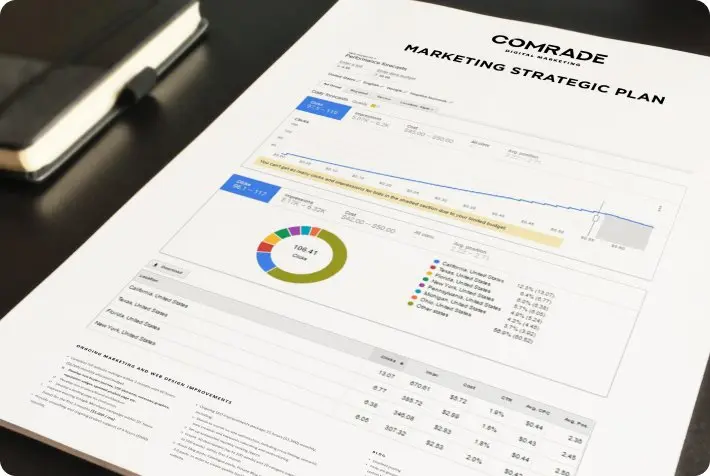Let’s do a fun experiment: Google (or ask ChatGPT) your service and city: E.g., “roof repair in Denver”.
Does your business show up on page #1?
Every day, people in your city search for home services just like yours. And every time you don’t appear, those calls go straight to another contractor’s phone.
Search engine optimization (SEO) is how you prevent that from happening.
With SEO, most companies start getting traffic and leads in just 3–6 months. Plus, SEO leads are 8.5X more likely to convert than TV, cold calls, radio, and email.
With that said, let’s dive into our 10-point action plan to dominate Google in 2026!

What Is Home Services SEO?
Home services SEO (or search engine optimization) is the process of making your business easy to find on Google or AI tools like ChatGPT, Gemini, and Perplexity.
Whether you’re a plumber, HVAC contractor, electrician, roofer, or cleaner, the goal is to get in front of the “right eyes”… i.e., people in your area who need your services!
And hey, the competition is fierce. Every day, new contractors pop up like weeds. Plus, over 75% of home service searches never go past page one.
SEO — good SEO — bumps up your rankings when local customers type in things like “AC repair near me” or “best electrician in [city].”
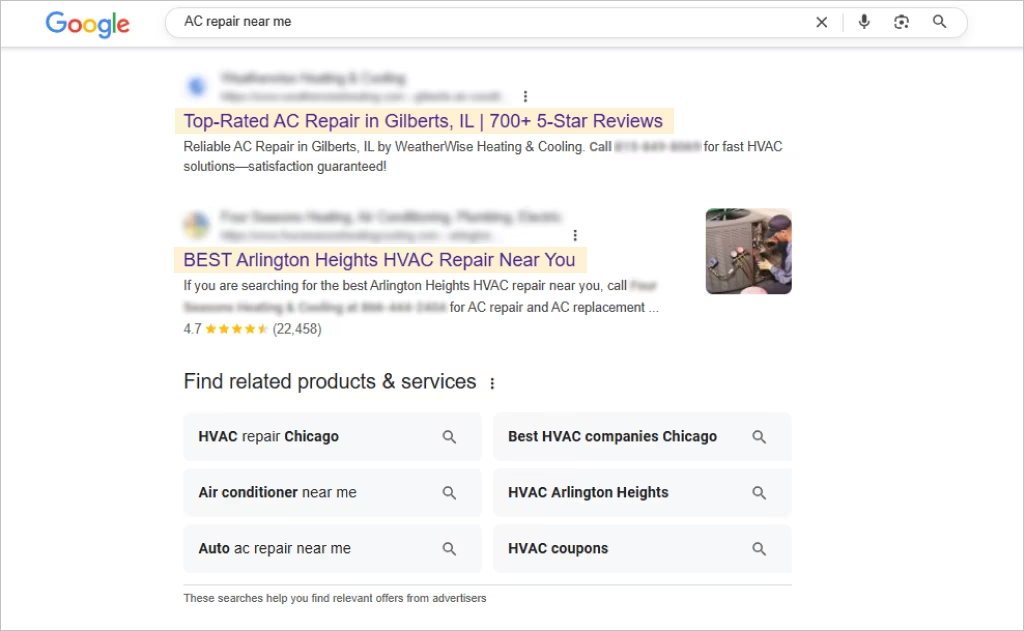
Like we said, with a good SEO strategy, in just 3 to 6 months, you could see more website visits, more phone calls, and more online leads. Love to hear it!
How Does Home Services SEO Work?
Home services SEO is about showing Google and AI tools like ChatGPT three things: who you are, what you do, and where you work. Here’s how to nab prime spots on search results:
- Keyword optimization: Find and use the exact searches people type, like “emergency plumber in Dallas” or “HVAC repair near me.” Nearly 46% of all Google searches are local!
- Google Business Profile: Keep it complete, accurate, and packed with reviews. Businesses with a complete profile get 7x more clicks.
- Service area pages: Build dedicated pages for each city or neighborhood you serve. More on this below!
- On-site fixes: Improve speed, titles, and content (your site should load in under 3 seconds or you risk losing 40% of your visitors right away).
Put these pieces together and you’ll see better local SEO rankings… meaning, homeowners will call you instead of “Joe Plumber” two blocks over.
What Are the Benefits of SEO for Home Service Businesses?
SEO hands you the ultimate trophy: more revenue. It’s not just about rankings on Google!
Good SEO gives you instant visibility, built-in trust (“if they’re at the top, they must be good”), and a steady flow of high-quality leads calling you.
Over time, you’ll stay ten steps ahead of competitors that don’t invest in SEO.

The Ultimate 10-Step SEO Formula for Home Service Success
Okay, let’s get to it! Here’s our 10 best practices to crush those top Google spots in 2026.
SEO for home services can seem daunting, but in the next 15 minutes, we’ll demystify the process for you.
1. Keyword Research & Competitor Analysis
What are your customers typing into Google? That’s at the heart of good SEO: knowing the exact phrases like “plumber near me,” “emergency AC repair,” or “roof leak repair Dallas.”
To uncover these home services keywords, use:
- Google Keyword Planner (free) → search volumes and related terms
- Ubersuggest or SEMrush → great for spotting long-tail searches like “24-hour furnace repair Chicago”
Then, run a competitor analysis:
- Plug competitor sites into Ahrefs or SEMrush to see what they rank for
- Check their backlinks to understand how they’re building authority
- Review their service pages and blogs to spot content gaps you can fill
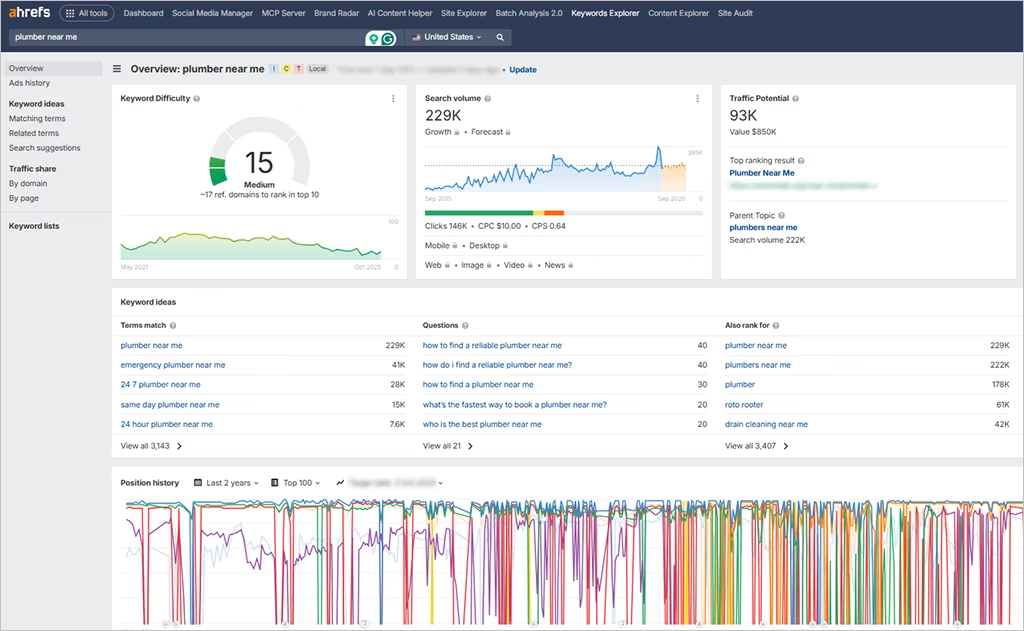
Balance is key in digital marketing: combine high-volume keywords for online visibility with local, intent-driven terms that bring in customers ready to call.
2. Optimizing Your Google Business Profile
Have you ever called a local business with missing hours and zero reviews? Exactly.
Your Google Business Profile is often the first impression customers get, and it can make or break whether they call.
- Complete your info: Hours, services, phone, website, service areas.
- Choose smart categories: One main service (Plumber) plus extras (Water Heater Repair, Drain Cleaning).
- Show proof: Upload photos of your team, trucks, and before/after jobs.
- Work the reviews: Ask for them and reply to them. Businesses with 9+ reviews earn an average of 53% more revenue.
- Pro Tip: Ask for reviews right after finishing a job — when the customer is the happiest.
- Stay fresh: Post updates, promos, and answer Q&As; profiles with regular updates get 5x more views than inactive ones.
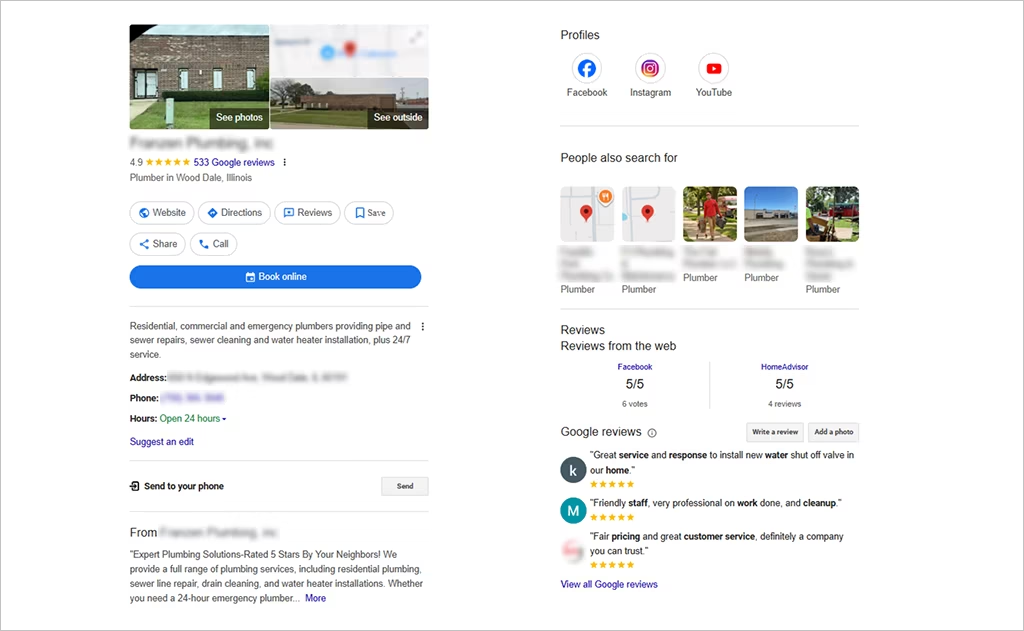
Sure, filling out your profile might sound like a lot. But it’s the kind of work that pays you back ten… twenty… and even thirty-fold!
3. On-Page SEO (Titles, Meta Tags, Headers)
So, your Google Business Profile is polished — wonderful!
Now let’s talk about your website. This is where you need on-page SEO. You’re basically sending Google the right “signals” so you actually show up when customers search.
Start with the basics:
- Title tags + meta descriptions: These are the little previews people see in Google. Make them keyword-rich and local… search intent matters:
- “24-Hour Plumber in Phoenix | Fast Emergency Service”
- “Chicago Roof Repair Experts – Free Estimates Today”
- Headers (H1, H2, H3): Your H1 is the main headline, H2s break up your services, and H3s add details. Sprinkle in location keywords naturally so Google connects you with local intent.
- Internal linking: Link to related pages (“See our water heater repair page”) so customers can navigate easily.
- Image alt text: Describe your photos with service and local (relevant) keywords. Google can’t “see” images, but it can read your alt text.
The effort is totally worth it. Pages with optimized title tags and meta descriptions get 5–10% higher click-through rates than those without.
4. Local SEO & NAP Consistency
There’s nothing… and we mean nothing… more frustrating than seeing conflicting info about a business.
Ask yourself: Is your NAP consistent? This is your Name, Address, and Phone number. It should match everywhere your business is listed online. Even tiny differences (like “St.” vs. “Street”) can confuse search engines.
- Start by cleaning up your listings on major local directories like Yelp, Angi (formerly Angie’s List), Houzz, and HomeAdvisor.
- Then move on to industry-specific sites and local chamber directories.
The more consistent your citations are, the stronger your local SEO for home services becomes.
P.S. NAP accuracy is a major factor in landing a spot in Google’s coveted map pack… that little box at the top with a map and 3 local businesses listed. That’s VIP placement!
5. Service Area Landing Pages Optimization
Alright — you’ve cleaned up your NAP. Now let’s plant a flag in every city you serve!
If you serve multiple cities or neighborhoods, one “service area” page isn’t enough. To really win at home services local SEO, you need a dedicated landing page for each location. On each one, use:
- Localized keywords: Bake the city into your headers, text, and meta tags (“Water Heater Repair in Austin”).
- Community details: Mention local landmarks or common issues (“We’ve patched more leaky roofs in Riverdale than we can count”).
- Calls-to-action: Add local phone numbers, booking forms, or even testimonials from customers in that local area.
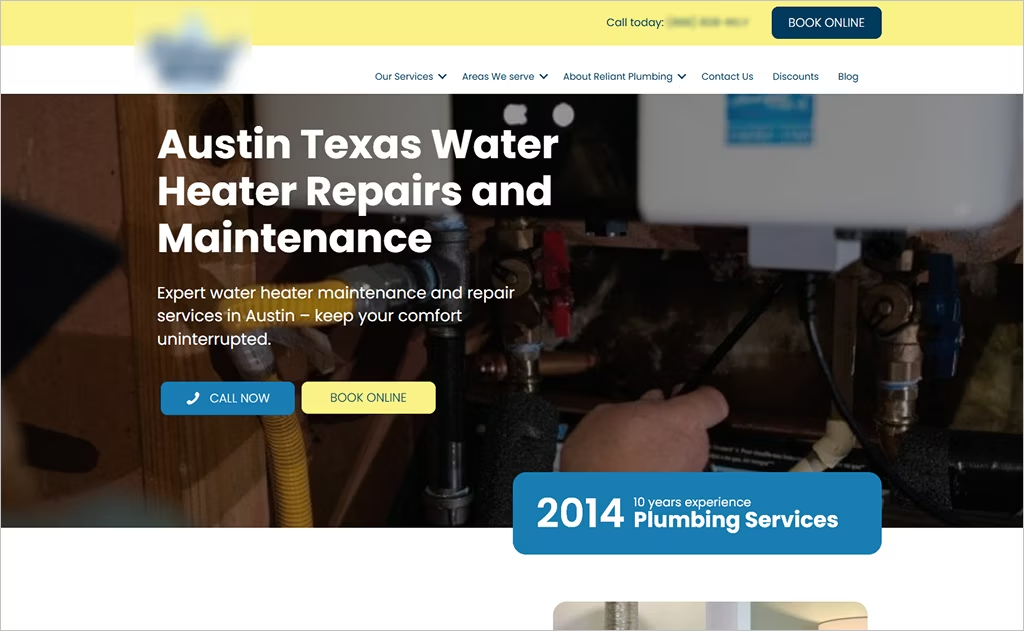
Be sure to make this a part of your marketing strategy. Businesses that use geo-targeted landing pages see up to 23% more conversion rates. Worth the effort? Totally!
6. Technical SEO & Site Speed Improvements
Nice, we’re halfway through our run on SEO for home services. Time to pop the hood and look at technical SEO:
- Site speed: 53% of users leave if a page takes over 3 seconds to load. Faster sites rank higher and get more calls.
- Mobile-first indexing: Google ranks your site based on its mobile version. If it’s clunky on a phone, you’ll slip.
- Core Web Vitals: Google measures speed, stability, and responsiveness, and rewards sites that score well.
Not up to speed with the above? Don’t worry. Start off with this:
- Test your site with PageSpeed Insights or GTmetrix.
- Compress images, clean code, and simplify design for speed.
- Use schema markup to label services, reviews, and contact info.
- Keep crawlability clean — fix broken links and submit sitemaps.
Optimizing for Language Models (LLMs)
Search isn’t standing still.
By 2026, over 30% of people will be asking AI tools like ChatGPT, Gemini, or Perplexity for answers instead of Googling.
You’ve got to think beyond basic SEO and start optimizing for LLMs (large language models).
Here’s the playbook to boost your home services SEO:
- Be useful. LLMs reward content that actually answers questions, not pages stuffed with random keywords.
- Give Google a cheat sheet. Schema markup labels your services, reviews, and service areas so AI instantly knows what you’re about.
- Keep it clean. Headings, bullet points, and alt text make your site easy for both humans and AI to digest.
- Lean on AI tools. SurferSEO, Clearscope, even ChatGPT can spot gaps and help create content LLMs love.
See how to get ChatGPT to recommend your business, explained by Ivan Vislavskiy
Sounds futuristic? Maybe. But you’ve already knocked out the hard stuff… this step just future-proofs you so when someone asks AI, “Who’s the best X near me?” your name pops up!
7. Mobile-Friendly Website Optimization
In 2026, that little metal rectangle in your pocket rules supreme.
More than 60% of searches now happen on mobile, and Google ranks your site based on its mobile version first — this is called mobile-first indexing.
For home service companies, that means your site has to look good and work smoothly on a small screen. Here’s how to nail it and show up in local search:
- Responsive design: Your site should adapt to any screen size without (ugh!) pinching and zooming.
- Clickable phone numbers: One tap should call you instantly, because no one wants to copy-paste a number.
- Simple navigation: Keep menus short and easy to tap with a thumb.
- Clear CTAs: Bold “Call Now” or “Book Service” buttons that stand out on mobile.
A mobile-friendly site is all about user experience. If your site makes life easier in a moment of stress, you’re getting that call.
The more calls, the more confirmation that your home services SEO is a success!
8. Content Marketing & Blogging for Local Topics
Content is everywhere! What you’re reading right now is content. The YouTube tutorial you watched last night is content.
Based on 1,400 websites, we know that companies that blog nab 67% more leads than those that don’t!
Look, your future customers are searching for answers every single day. Content marketing for home services is your chance to seize their attention… and (slowly but surely) their business.
- Seasonal maintenance tips (“How to keep your pipes from freezing in Chicago”)
- Local guides (“5 roof repair tips every Dallas homeowner should know”)
- Quick FAQs that answer questions customers are Googling right now
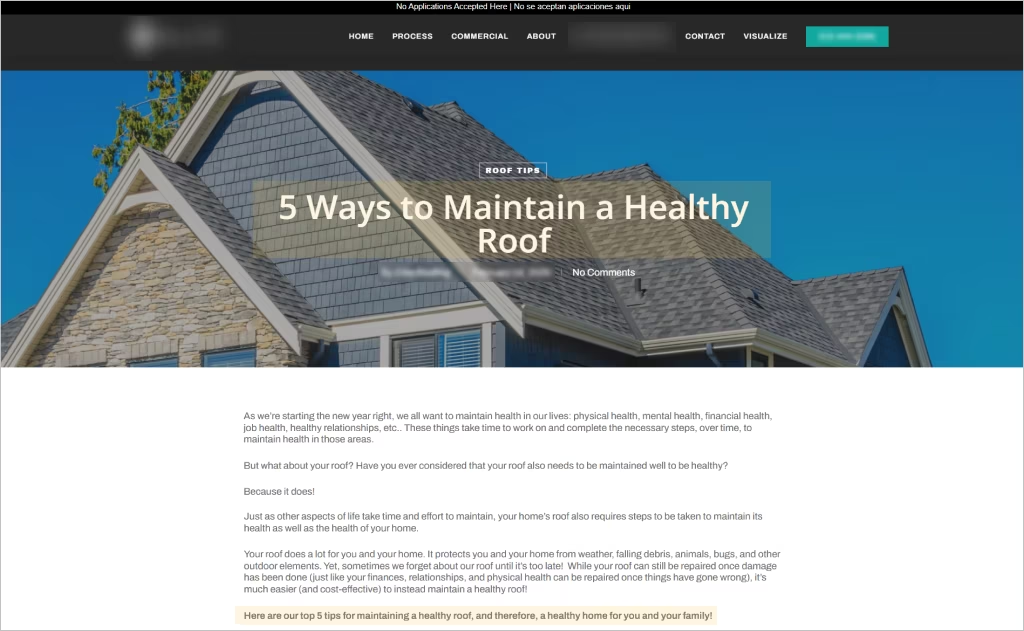
Add a clear CTA at the end — “Call now,” “Get a free quote,” etc. — and your blog will generate leads like there’s no tomorrow!
9. Building Local Citations & Backlinks
Want a “secret pass” into Google’s inner circle? It comes down to citations and backlinks.
Citations are your business name, address, and phone number listed the same way across sites like Yelp, Angi, or Houzz.
Backlinks are when other websites link to yours. That’s like someone with sway vouching for you at the door to get you into the club.
Here’s how to earn them and boost your SEO for home services:
- Partner with local businesses and cross-promote on websites and social media.
- Sponsor community events or sports teams (and win a backlink on their site).
- Share expert tips with local news (“How to stop pipes from freezing in January”).
Keep hustling with link building. Strong backlinks can lift your search rankings by 20% or more. This is a great move to grow your business’ online rep.
10. Tracking SEO Performance & Analytics
You’ve put in a lot of work. By now, you’ve optimized your site, built out local pages, and even prepped for AI. Whew, grab a cool drink, you earned it.
But there is one final step that makes all of it pay off: tracking your results. Make sure to track these key metrics:
- Organic traffic: Are more people finding you through Google?
- Local rankings: Are you climbing in the map pack for searches like “plumber near me”?
- Leads + conversions: Calls, form submissions, and quote requests, because rankings only matter if they turn into jobs.
Use free tools to track your progress: Google Analytics for traffic and conversions, and Google Search Console for keyword rankings and visibility.
Keep tracking, and you’ll know exactly how to bump up those ROI numbers.
Let’s Grow Your Home Services Business In 2026!
Congratulations, you’ve just walked through our full SEO playbook. Here are the highlights:
- Show up where it counts: Optimize your Google Business Profile.
- Be local, be relevant: Service area pages, local keywords, and community-focused content.
- Stay fast and mobile-friendly: Your customers won’t wait.
- Earn authority: Reviews, citations, and backlinks prove you’re credible.
- Keep score: Track traffic, rankings, and calls so you know where to invest.
But here’s the thing — you’re already busy running your business. Do you really have the time to manage SEO too?
Get Comrade on the job. As a home services SEO company with 18+ years of expertise, our clients see up to 820% ROI in year one.
Protect your pipeline and get steady leads, all year long.

